about the march for science
April 30th, 2017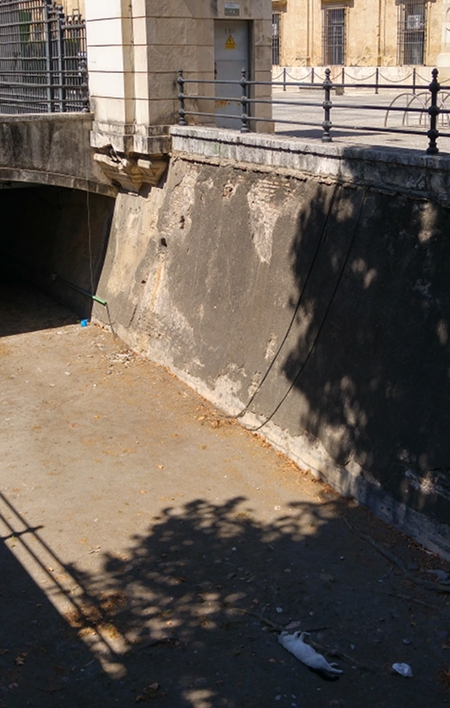
Very dead looking cat in front of the Universidad de Sevilla
I didn’t go to the march for science.
randformblog on math, physics, art, and design |

Very dead looking cat in front of the Universidad de Sevilla
I didn’t go to the march for science.
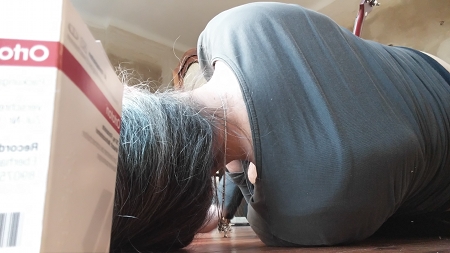
“End-Hauptbereichsverspannungsmedikamente für Nacknmuskuleere Speerre” collaborative artwork by artists group “Entente Sublimale”
More or less recently I had seen a video in which a famous politician was talking in a way which gave me the impression that this person was on drugs. I may have been wrong, but still. It should be said that in the video the person had to comment on a very tragic event and that was sofar the only time where I saw this politician in this state.
Then there was also Jeroen Dijsselbloems recent controversial remarks about economic failures due to alcohol and women and the following discussions, where it was e.g. remarked that after taking interest payments away, the economics of the Netherlands seems to look actually worse than that of Southern Europe. All this made me look a bit at examples of drugs and in particular opiods in connection with economics and politics.
Read the rest of this entry »
You might remember the randform post “Death of a pub” about the demolishment of a traditional Berlin pub/restaurant/dancehall. Meanwhile the restaurant got replaced by a building which provides room for two small facilities. One of the facilities, which hosts currently a little pub called “Schranke” (“barrier” or “level-crossing”) has a little beer terrace/garden next to the buidling. The other business sells Doner kebab and is called “Dönerhaus”. The former garden of the restaurant had been integrated into a parking lot. The images below and above display the new public space situation at the station. Judge yourself whether this is an improvement.
Read the rest of this entry »
Some remarks on the recent observations regarding plant 2.
Read the rest of this entry »
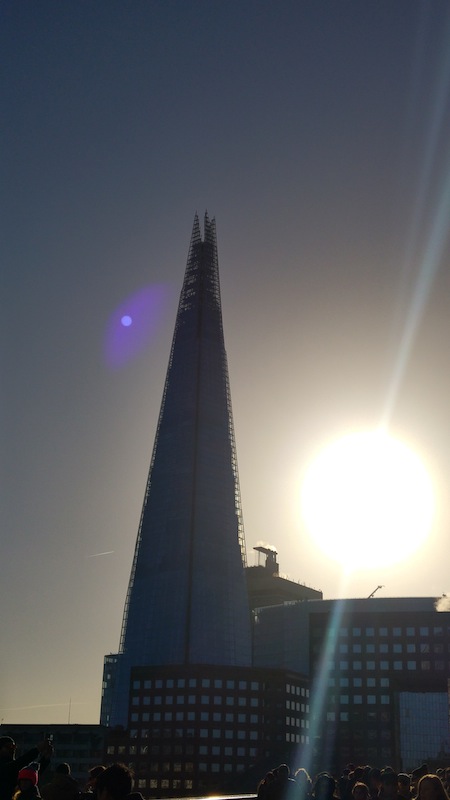
Planetary science at The Shard: How soon is the sun’s radiation going to be destructive? (apart from the effect on the CCD chip)
This blog post is based on a thread in the Azimuth forum.
The current theories about the sun’s life-time indicate that the sun will turn in about 5 billion years into a red giant. How and when this process is going to be destructive to earth is still debated. Apparently according to more or less current theories there has been a quasi linear raise in luminosity, quoting from p. 3 “Distant future of the Sun and Earth revisited” by K.-P. Schröder and Robert Connon Smith, 2008:
The present Sun is increasing its average luminosity at a rate
of 1% in every 110 million years, or 10% over the next billion years.
Unfortunately I feel a bit doubtful about this, in particular after I looked at some irradiation measurements.
But let’s recap a bit.
In the Azimuth forum I asked for information about solar irradiance measurements. Why I was originally interested in how bright the sun is shining is a longer story, which includes discussions about the global warming potential of methane. For this post I prefer to omit this lengthy historical survey about my original motivations (may be I come back to this later) – meanwhile (see above) there is an also a newer reason why I am interested in solar irradiance measurements, which I want to talk about here.
Strictly speaking I was not only interested in knowing more about how bright the sun is shining, but how bright each of it’s “components” is shining, i.e. I liked to see spectrally resolved solar irradiance measurements and in particular measurements from a range between roughly the frequencies* 650nm and 950nm.
So I had found the Sorce mission, which is a NASA sponsored satellite mission, whose website is located at the University of Colorado. The website provides very nicely an interactive part with a fairly clear and intuitive LISIRD interactive app with which the spectral measurements of the sun can be studied.
As a side remark I should mention that this NASA mission belongs to the NASA Earth Science mission, which is currently threatened to be scrapped.
By using this app I found in the 650nm and 950nm range a very strange rise in radiation between 2003 and 2016 which happened mainly in the last 2-3 years. Here you can see this rise:
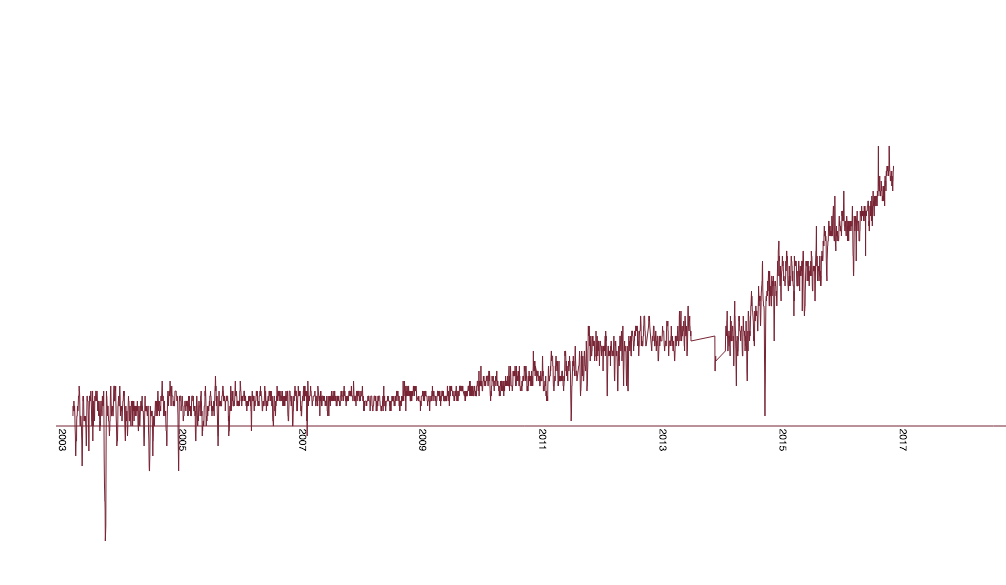
spectral line 774.5nm from day 132 to 5073, day 132 starting Jan 24 in 2003, day 5073 is end of 2016
Now, fluctuations within certain spectral ranges within the sun spectrum are no news, however here it rather looked as if a rather stable range suddenly started to change rather “dramatically”.
I put the word “dramatically” in quotes for a couple of reasons.
Spectral measurements are complicated and prone to measurement errors. Alone the subtle issue of dirty lenses etc. suggests that this is no easy feat and that so this strange rise might easily be due to a measurement failure. Moreover as said it looked as this was a fairly stable range over the course of ten years, but maybe this new rise in irradiation is part of the 11 years sun cycle, i.e. a common phenomenom. In addition, although the rise looks big it may overall still be rather subtle.
But so – how subtle or non-subtle is it then?
In order to assess that question I made a quick estimation (see forum discussion) and found that if all the additional radiation would arrive on soil (which of course it doesn’t due to absorption) than on 1000 sqm you could easily power a lawn mower with that subtle change! I.e. my estimation was 1200 W for that lawn patch. WOA!
That was disconcerting enough to download the data and linearly interpolate it and calculate the power of that change. I programmed a calculation program in javascript for that. The computer calculations revealed 1000 W, i.e. my estimation was fairly close. WOA again!
How does this translate to overall changes in solar irradiance? Some increase had already been noticed. NASA wrote 2003 on it’s webpage:
Although the inferred increase of solar irradiance in 24 years, about 0.1 percent, is not enough to cause notable climate change, the trend would be important if maintained for a century or more.
That was 13 ys. ago.
I now used my program to calculate the irradiance for one day in 2016 between the frequencies 180.5nm and 1797.62nm, i.e. about a quite big part of the solar spectrum and got the value $latex 627 W/m^2$ and computed the difference to one day in 2003 and got $latex 0.61 W/m^2$, which is 0.1% in 13 years, rather then 24 years. But of course this is no average and fluctuations play a big role in some parts of the spectrum, but well – this may indicate that the overall rate (!) of rise in solar radiation may have doubled. And concerning the question of the sun’s luminosity: for assessing luminosity one would need to take the concrete satellite-earth orbit at the day of measurement into account, as the distance to the sun varies or at least average – but still, on a first glance this appears disconcerting.
Moreover for this specific range I mentioned above I calculated the value $latex 192 W/m^2$ for day in 2016 (day 5073), so this would mean for this frequency range the increase in 13 ys was about 0.5% and most of it in the last 2-3 years.
Given that this spectral range has e.g. an overlap with the absorption of water (clouds!) this should at least be discussed.
And indeed one can even see the rise in this range within the solar spectrum without zooming in. See how the spectrum splits into a purple and dark red line in the lower circle?
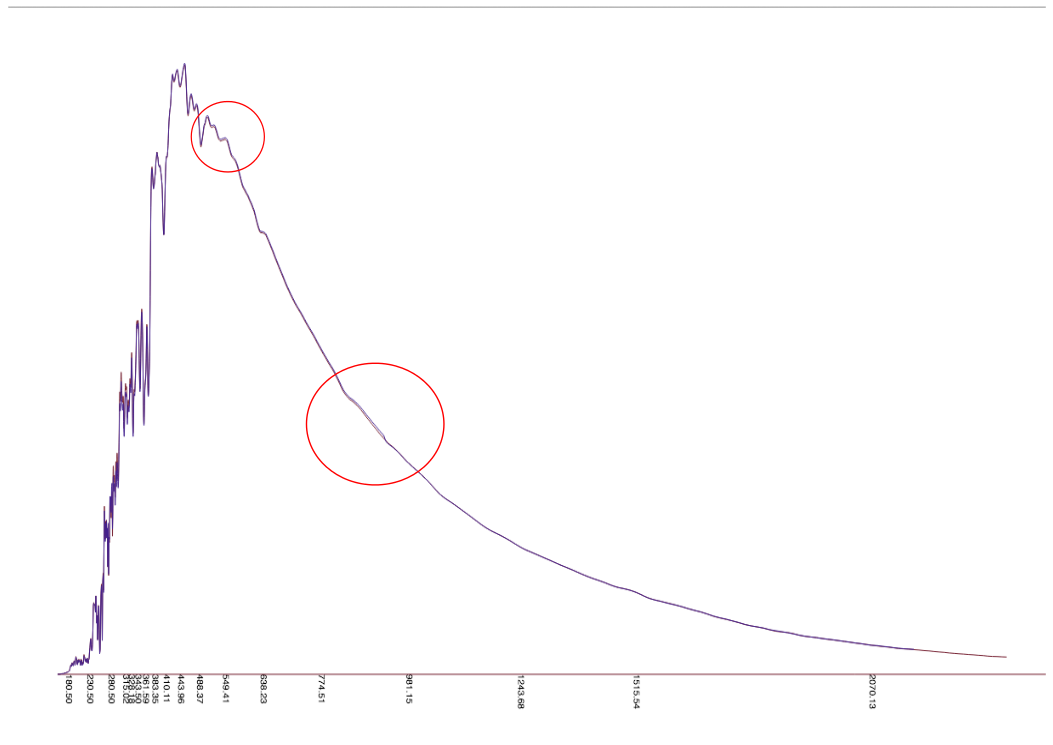
Difference in spectrum between day 132 and 5073
The upper circle display another rise, which is discussed in the forum.
So concluding all this looks as if this needs to be monitored a bit more closely. Finally the theories about the lifetime of the sun are only theories.
In particular it would be important to see wether these rises in irradiance are also displayed in other measurements, so I asked in the Azimuth Forum, but sofar got no answer.
The russian wikipedia site about solar irradiance contains unfortunately no links to russian satellite missions (if I haven’t overseen something) and there exists no chinese or indian wikipedia webpage about solar irradiance. I also couldn’t find publicly accessible spectral irradiance measurements on the ESA website (although they have some satellites out there) and wrote in December an email to the head of the section solar radiometry of the World Radiation Center (WRC) Wolfgang Finsterle with no answer yet.
In short if you know about publicly available solar spectral irradiance measurements other than the LISIRD ones then please let me know.
update Jan 15, 2017: This post appeared also as a guest post on John Baez blog Azimuth with minor modifications, in particular the english was polished by John.
correction Feb, 3, 2017: * frequencies should read inverse spatial frequencies or simply wavelength
update Mar 4, 2019: There is an update to this post at randform post: What is going on at the Sun?
In the randform post “Gesture steered Turing machine” I used data gloves, which were made following the instructions of Hannah Perner-Wilson who is a member of the gloves project. Being weary of sitting too much at the computer I had also written in this post that I would like to make more use of body movements and in particular include danse-like movements in computer interaction and in particular in programming.
Unfortunately rather shortly after I had written the post a not so nice medical indication in my vicinity which was -at least partially- due to too much computer sitting urged me to more or less dramatically speed up this project.
The gesture recognition for my gloves, which were used in the Turing machine example, works, but it is not yet fine grained and exhaustive enough. So I had to look for an easy and fast and at least to some extend workable and affordable solution which would insure a more direct and precise steering possibility, like some version of key gloves. To make it short: In the end I made my own version with Tims help. Again it’s only a start but still.
There was a bit of discussion going on about the last image in the last post which displays two emergency switches on a wall in the radio museum. On the switches there were the words “Diesel” and “Schaltfeld (switch board).” Above the switches there were two signs, each with the message: “Es darf nur eine Laufkatze betrieben werden” (There musn’t be more than one hoist in operation”). I was guessing that “Diesel” meant eventually the Diesel generator within the museum building which served -if I understood correctly- mainly as an emergency power system. So here now images from the Diesel generator.
Read the rest of this entry »
Todays post deals with the transmission and radio technology museum at a former transmission facility in the town of Königs-Wusterhausen close by Berlin (the town is reachable by Berlin subway). The facility is located on a hill and rather big (Flight over the the facility including its museum (building with red tiles)). The museum is definitely a must-see.

Sandhauser Strasse in Heiligensee next to the old riflemans house
In the randform post Heiligensee I hypothesized that an ancient oral tradition from the village of Heiligensee might indicate that cults of the germanic goddess Nerthus could have taken place there. I am fully aware that this is super speculative and in particular that it is outrageously unlikely that there is an oral tradition in Berlin which is 1500-to 4000 years old (thats approx. when the semnones lived there). It would not be too far fetched to assume that the tales of Nerthus were converted into tales matching the surroundings of Heiligensee. Nevertheless it should be reminded of that there are oral traditions which lastet for rather long time like the vedas (with by the way interesting error correcting schemes).
Anyways for me the the oral tradition was so compelling close to the Nerthus tales and to the fact that there might have been an ancient sacred location that I was motivated enough to travel to the other side of Berlin and to look for something like a sacred grove, a thing location on a raised mound and/or even a tumulus like in Old Uppsala. That is I looked at the hills across from Sandhauserstr.99 which are called Schifferberge. It should be said that in this area dune hills are rather common, so that when I started out I was quite convinced that the option tumulus was rather a joke. That is I was convinced that the Schifferberge are just dunes instead of containing a tumulus, but I am not so sure anmore. But see the images.
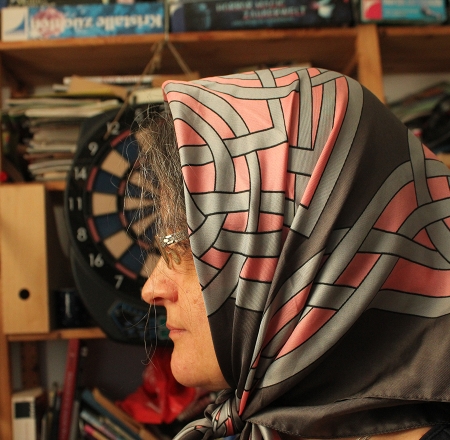
Me, wearing my newly acquired knotty headscar from Dublin (some of my math research involved knot theory)
School education in Germany is federal, so the choice of subjects may be different wether you live in Berlin or Bavaria. In Germany there exists a school subject called “religion”, which if obligatory may usually be substituted by an irreligious variant called e.g. “ethics.” There are still big discussions (even in Berlin) wether the subject should be obligatory or not.